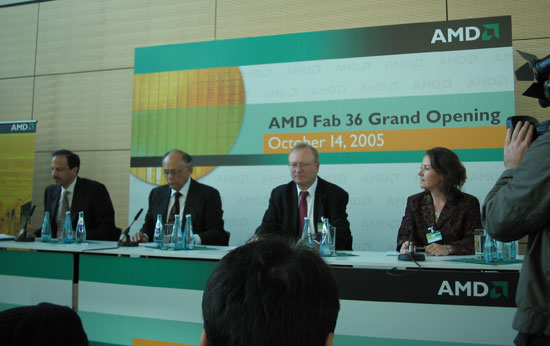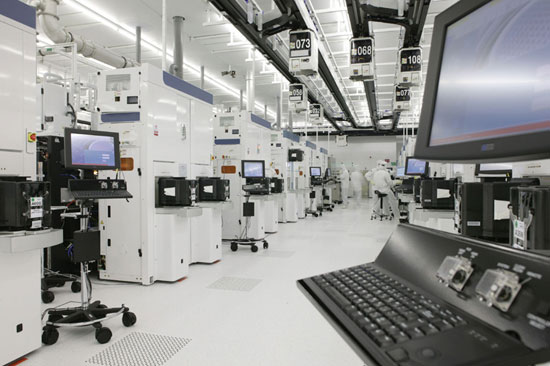An AMD Update: Fab 36 Begins Shipments, Planning for 65nm and AM2 Performance
by Anand Lal Shimpi on April 4, 2006 11:00 AM EST- Posted in
- CPUs
A little under 6 months ago AMD introduced their first 300mm 90nm manufacturing facility, called Fab 36. The name of course comes from its existence 36 years after the founding of AMD, with the plant itself being located next to Fab 30 in Dresden, Germany.
The grand opening of Fab 36 was mostly for media attention as the plant would not begin shipping revenue parts until Q1 of 2006. That sometime is today as AMD has just announced that Fab 36 is finally shipping revenue parts. The parts that it is shipping are 90nm Athlon 64 and Sempron CPUs, so Opterons and Athlon 64 X2s will still come out of Fab 30 next door. AMD cites customer demand as the reason that Athlon 64 and Sempron are first out of the new fab, which honestly makes sense; there's always need for more capacity at the lower end.

Although both Fab 30 and Fab 36 produce 90nm processors, Fab 30 uses smaller 200mm wafers while Fab 36 features an upgrade to 300mm wafers. AMD says that yields on 300mm wafers coming out of Fab 36 are comparable to 200mm yields being produced at Fab 30.

In terms of capacity, by 2008 AMD plans to be able to crank out 20,000 (300mm) wafers per month out of Fab 36 which would double its microprocessor production capacity to approximately 100M CPUs per year (thanks to larger wafers and smaller transistors). For comparison, Fab 30 currently produces 30,000 (200mm) wafers per month. Unfortunately AMD was unable to provide us with any sort of guidance as to how quickly Fab 36 will ramp up to its 20K per month target. AMD's partnership with Chartered Semiconductor Manufacturing Ltd. out of Singapore will guarantee additional 90nm production capacity beginning in the second half of this year. By the end of this year, AMD's capacity will have increased tremendously over the single fab they had producing 90nm parts previously.
As we mentioned in our initial coverage of Fab 36's grand opening, all parts shipping out of the plant will be 90nm, with AMD converting to 65nm starting in the second half of this year. Fab 36 will be "substantially converted" to 65nm manufacturing by the middle of 2007. Once again, AMD wasn't able to provide us with any sort of concrete details about the ramp to 65nm. It could very well be that AMD will be shipping lots of revenue generating 65nm parts by the end of this year, or they could be shipping very little. If the latter is true, then AMD's real transition to 65nm won't occur until far into 2007. When it does happen however, the move to 65nm will bring about smaller die sizes, faster switching transistors and lower power consumption for AMD, just as it has for Intel. AMD's 65nm process will incorporate their third generation of SOI technology to further reduce power consumption. AMD is promising a 40% increase in transistor performance with the move to 65nm thanks to the smaller process and the third generation SOI technology.

Fab 36 in Action










68 Comments
View All Comments
Viditor - Wednesday, April 5, 2006 - link
No, I said AMD hadn't released any estimates...this article was not from AMD.
fikimiki - Wednesday, April 5, 2006 - link
Hector Ruiz said:http://www.fabtech.org/index.php?option=content&am...">Here:"Our latest projections average out certain factors, but we feel it is not unreasonable for Fab 36 to have 26,000wspm by the end of 2006. Then depending on a host of factors, fab capacity would be reached sometime in the 1H07."
And because of 65nm transitions they have to lower a production output to ~17wspm. Fab36 was not designed to have smaller production output than FAB30 - for sure...
coldpower27 - Wednesday, April 5, 2006 - link
26K WSPM by end of 2006? When AMD is claiming 20K WSPM by 2008, don't you find that somewhat odd?Viditor - Wednesday, April 5, 2006 - link
That would be the old numbers...AMD has increased the efficiency of their Fabs. For example, Fab30 was originally to max out at 20k wspm and now does 30k. AFAIK, AMD has not released current capacity estimates for Fab 36.
Questar - Wednesday, April 5, 2006 - link
"To ameliorate some of the financial risks, AMD will not completely build out the facility just yet. As it stands now, AMD can start production on 13,000 silicon wafers a month. Enough empty space, however, exists to crank that up to 20,000 wafer starts a month. Getting to the 100 million mark will involve populating the current empty space in the 13,400-square-meter plant with equipment."http://news.com.com/With+new+factory%2C+AMD+ups+an...">http://news.com.com/With+new+factory%2C.../2100-10...
Viditor - Wednesday, April 5, 2006 - link
It doesn't really matter, but the article is from the Grand Opening in October.The key point here is the number 15,000wspm. That represents (on 300mm) a doubling of capacity. By this years end, between Fab 36 and Chartered we will most likely see a tripling of capacity.
coldpower27 - Wednesday, April 5, 2006 - link
Well since this article was released later, I am going to go with what is here as more accurate, I don't see any reason to beleive the Fabtech document versus what is written here.defter - Wednesday, April 5, 2006 - link
No he didn't. That article contains guesses and estimates of fabtech.org and according to their page, that article is already quite old. For example they are talking about ramp starting in Q1 although shipments only began in Q2.
Viditor - Wednesday, April 5, 2006 - link
Actually, the ramp began at the end of Q4 05...it takes about 3 months for shipping product after a ramp begins.
mesyn191 - Wednesday, April 5, 2006 - link
Yea, I'd be suprised if we saw more than a 20% clockspeed improvement over .90 chips assumig the .65 chip is just a die shrink with no clocspeed optimizations made of course.